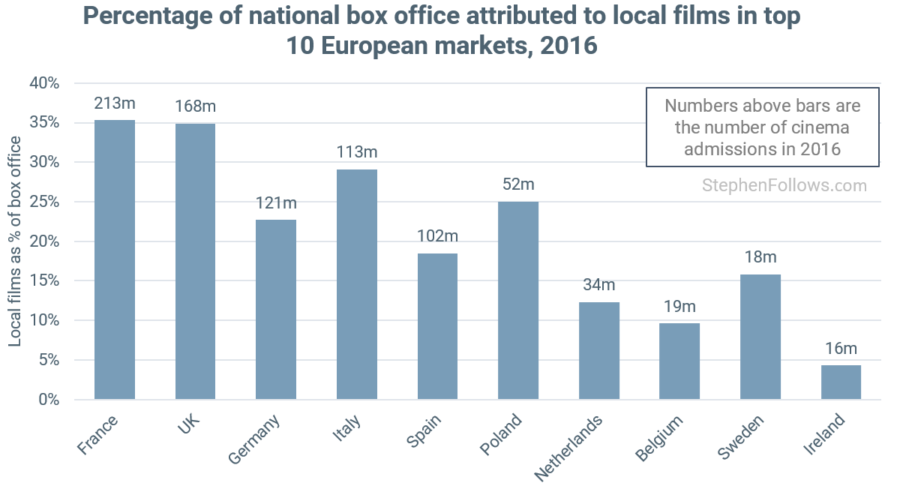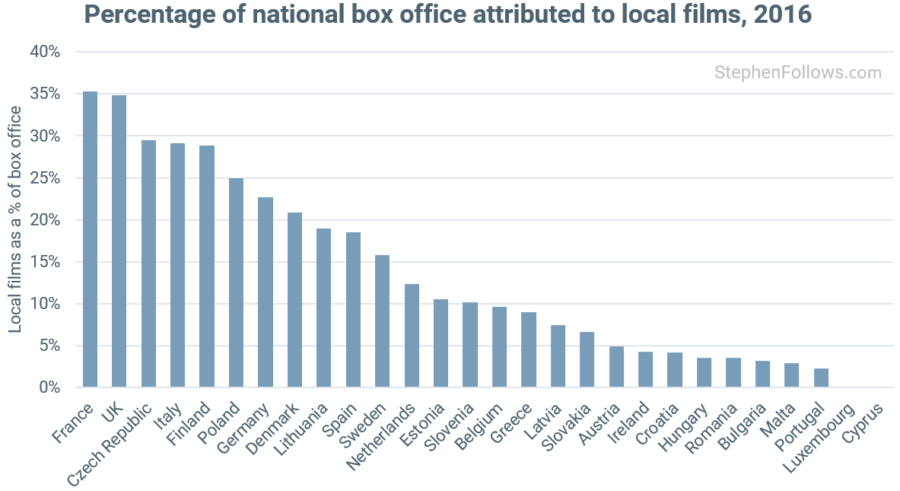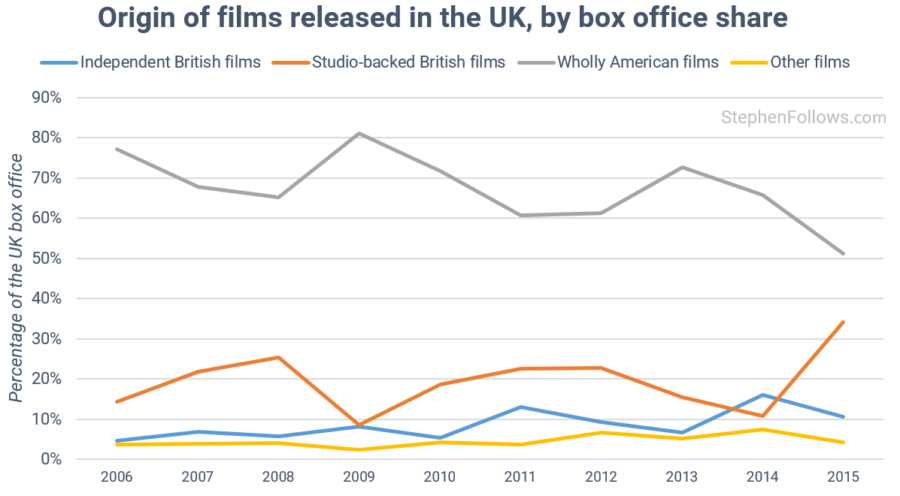 A few weeks ago, I looked at how much of Hollywood’s box office cinema is earned outside North America. The figure for 2016 was 63%, meaning that just 37% of the box office gross for Hollywood movies was from US and Canadian cinemas. This prompted a few people to get in contact to ask how this compares to the film industries of other countries.
A few weeks ago, I looked at how much of Hollywood’s box office cinema is earned outside North America. The figure for 2016 was 63%, meaning that just 37% of the box office gross for Hollywood movies was from US and Canadian cinemas. This prompted a few people to get in contact to ask how this compares to the film industries of other countries.
I’m going to focus on European countries as these are the ones for which I have the most complete and equivalent data.
Local films in the top 10 European film markets
Let’s start by looking at the top ten film markets in Europe. France is both the largest market (213 million admissions last year) and also had the highest share of box office income going to local films last year (35.3%). This is in large part due to the government intervention the French film industry enjoys. The French are so committed to their state support for French cinema that they have carved out “l’exception culturelle” (literally: cultural exception) for movies when the EU negotiates free-trade deals with non-EU nations. This means that the French can continue to place tariffs and quotas on foreign movies, as well as requiring French TV stations to back French movies. Together, they create a pretty healthy market for local films in France.
The UK follows very close behind, although for almost the opposite reason. Whereas the French are pushing away American movies, the British are accepting them as one of their own, meaning they count towards the ‘local film’ box office. I’ll address the UK situation in a bit more detail later in this article.

Local films in all European film markets
If we zoom out from the biggest markets to look at all European countries for which I could find data. France and the UK keep their positions as top markets for local films but are joined by the Czech Republic, Finland, Denmark and Lithuania. At the other end of the spectrum, we can see that local films perform very badly in Cyprus, Luxembourg, Portugal and Malta.

Local films at the UK box office
In the previous section we saw that in 2016, 35% of the UK box office went to British films. This may sound high but has actually fallen from the 2015 figure of 45%.

 Many British cinema-goers may be surprised to hear that between a third and half of the UK box office is collected by British films. That’s because the definition of a British film is rather broad. We tend to think of British films as those that actively reflect an image of the UK, such as Trainspotting, The King’s Speech or Kidulthood, but in fact, there are a number of Hollywood blockbusters that are also legally British films, including many Marvel movies and the new brood of Star Wars movies.
Many British cinema-goers may be surprised to hear that between a third and half of the UK box office is collected by British films. That’s because the definition of a British film is rather broad. We tend to think of British films as those that actively reflect an image of the UK, such as Trainspotting, The King’s Speech or Kidulthood, but in fact, there are a number of Hollywood blockbusters that are also legally British films, including many Marvel movies and the new brood of Star Wars movies.
So let’s split apart the term ‘local film’ and look at how much of the UK box office is collected by UK independent and UK studio-backed movies.
Over half the UK box office goes to wholly-American movies, with another third going to Hollywood movies which are officially classed as British films, thanks mostly to their production and post-production being conducted in the UK. In 2016, UK independent movies only took 10.5% of the UK box office.

If you would like to explore the topic of what a British film is then you may enjoy some of these articles:
- Quiz: Guess which movies are officially British
- Are British films better than Hollywood films?
- The state of the UK film industry
Data
The data for today’s article came from a number of places, including the British Film Institute, European Audiovisual Observatory, SPF Economie, Cinedata, La Fédération des Cinémas de Belgique, Belgian Entertainment Association, National Film Center, Cyprus Ministry of Education and Culture, Czech State Cinematography Fund, FFA, Statistics Denmark, Danish Film Institute, Estonian Film Institute, ICAA, Finnish Film Foundation, Le Centre national du cinéma et de l’image animée, Cinema Advertisers Association, comScore, Greek Film Center, Croatian Audiovisual Center, National Film Office, MEDIA LIVE, Irish Film Board, Cinetel, SIAE, ANICA, Lithuanian Film Center, MEDIA Salles, National Film Center, National Statistics Office, Netherlands Film Festival, MaccsBox, Film Distributeurs Nederland, Polish Film Institute, boxoffice.pl, Cinema E Audiovisual Portugues, Centru National al Cinematografiei, Swedish Film Institute, Slovenian Film Institute, Únia filmových distribútorov and Slovak Film Institute.
Standardising data across a number of countries is always tricky. Each country measures a slightly different thing and some definitions can change across borders. Some of the numbers have been estimated, either by the local bodies or the EAO. The UK box office includes cinemas in both the United Kingdom and the Republic of Ireland, as they are treated as one distribution territory. The figures for Malta are from 2015, not 2016 as more recent figures were not available.
Epilogue
Today’s topic came from a few readers. If you have a question you’d like me to answer, then drop me a line.





Comments
Thank you. Interesting as ever.
I’m not sure that it’s strictly right to say that local films perform badly in Cyprus, Luxembourg, etc. They’re just too small to have a domestic film industry: they maybe didn’t serve up a single distributed film in the period. Generally the European countries with the highest proportion of local viewing are those with the largest populations – with a few exceptions, e.g. Germany. Maybe the best way to compare this data would be on a scatter-graph of local viewing against population, which would highlight the countries that outperform and underperfrom.